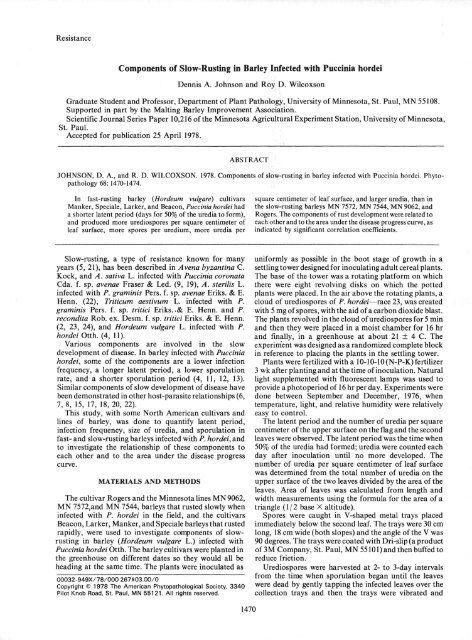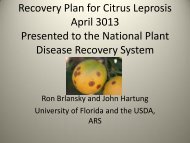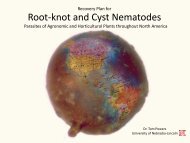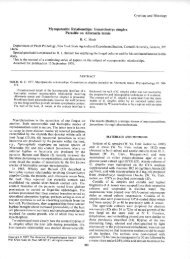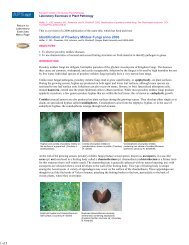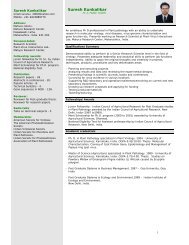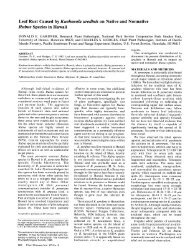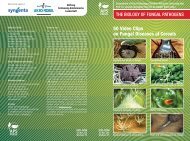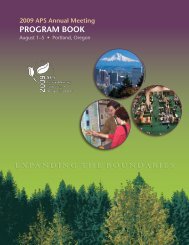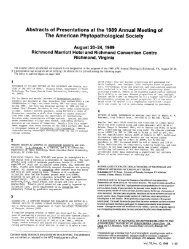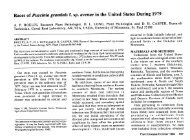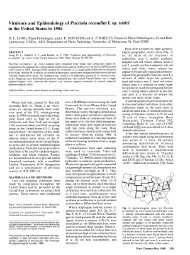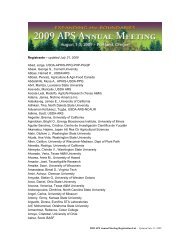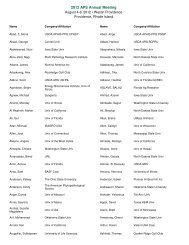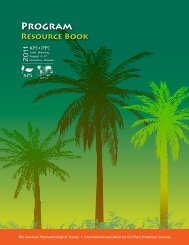Components of Slow-Rusting in Barley Infected with Puccinia hordei ...
Components of Slow-Rusting in Barley Infected with Puccinia hordei ...
Components of Slow-Rusting in Barley Infected with Puccinia hordei ...
You also want an ePaper? Increase the reach of your titles
YUMPU automatically turns print PDFs into web optimized ePapers that Google loves.
Resistance<br />
<strong>Components</strong> <strong>of</strong> <strong>Slow</strong>-<strong>Rust<strong>in</strong>g</strong> <strong>in</strong> <strong>Barley</strong> <strong>Infected</strong> <strong>with</strong> Pucc<strong>in</strong>ia <strong>hordei</strong><br />
Dennis A. Johnson and Roy D. Wilcoxson<br />
Graduate Student and Pr<strong>of</strong>essor, Department <strong>of</strong> Plant Pathology, University <strong>of</strong> M<strong>in</strong>nesota, St. Paul, MN 55108.<br />
Supported <strong>in</strong> part by the Malt<strong>in</strong>g <strong>Barley</strong> Improvement Association.<br />
Scientific Journal Series Paper 10,216 <strong>of</strong> the M<strong>in</strong>nesota Agricultural Experiment Station, University <strong>of</strong> M<strong>in</strong>nesota,<br />
St. Paul.<br />
Accepted for publication 25 April 1978.<br />
ABSTRACT<br />
JOHNSON, D. A., and R. D. WILCOXSON. 1978. <strong>Components</strong> <strong>of</strong> slow-rust<strong>in</strong>g <strong>in</strong> barley <strong>in</strong>fected <strong>with</strong> Pucc<strong>in</strong>ia <strong>hordei</strong>. Phytopathology<br />
68: 1470-1474.<br />
In fast-rust<strong>in</strong>g barley (Hordeum vulgare) cultivars square centimeter <strong>of</strong> leaf surface, and larger uredia, than <strong>in</strong><br />
Manker, Speciale, Larker, and Beacon, Pucc<strong>in</strong>ia <strong>hordei</strong> had the slow-rust<strong>in</strong>g barleys MN 7572, MN 7544, MN 9062, and<br />
a shorter latent period (days for 50% <strong>of</strong> the uredia to form), Rogers. The components <strong>of</strong> rust development were related to<br />
and produced more urediospores per square centimeter <strong>of</strong> each other and to the area under the disease progress curve, as<br />
leaf surface, more spores per uredium, more uredia per <strong>in</strong>dicated by significant correlation coefficients.<br />
<strong>Slow</strong>-rust<strong>in</strong>g, a type <strong>of</strong> resistance known for many uniformly as possible <strong>in</strong> the boot stage <strong>of</strong> growth <strong>in</strong> a<br />
years (5, 21), has been described <strong>in</strong> Avena byzant<strong>in</strong>a C. settl<strong>in</strong>g tower designed for <strong>in</strong>oculat<strong>in</strong>g adult cereal plants.<br />
Kock, and A. sativa L. <strong>in</strong>fected <strong>with</strong> Pucc<strong>in</strong>ia coronata The base <strong>of</strong> the tower was a rotat<strong>in</strong>g platform on which<br />
Cda. f. sp. avenae Fraser & Led. (9, 19), A. sterilis L. there were eight revolv<strong>in</strong>g disks on which the potted<br />
<strong>in</strong>fected <strong>with</strong> P. gram<strong>in</strong>is Pers. f. sp. avenae Eriks. & E. plants were placed. In the air above the rotat<strong>in</strong>g plants, a<br />
Henn. (22), Triticum aestivum L. <strong>in</strong>fected <strong>with</strong> P. cloud <strong>of</strong> urediospores <strong>of</strong> P. <strong>hordei</strong>-race 23, was created<br />
gram<strong>in</strong>is Pers. f. sp. tritici Eriks. .& E. Henn. and P. <strong>with</strong> 5 mg <strong>of</strong> spores, <strong>with</strong> the aid <strong>of</strong> a carbon dioxide blast.<br />
recondita Rob. ex. Desm. f. sp. tritici Eriks. & E. Henn. The plants revolved <strong>in</strong> the cloud <strong>of</strong> urediospores for 5 m<strong>in</strong><br />
(2, 23, 24), and Hordeum vulgare L. <strong>in</strong>fected <strong>with</strong> P. and then they were placed <strong>in</strong> a moist chamber for 16 hr<br />
<strong>hordei</strong> Otth. (4, 11). and f<strong>in</strong>ally, <strong>in</strong> a greenhouse at about 21 ± 4 C. The<br />
Various components are <strong>in</strong>volved <strong>in</strong> the slow experirrient was designed as a randomized complete block<br />
development <strong>of</strong> disease. In barley <strong>in</strong>fected <strong>with</strong> Pucc<strong>in</strong>ia <strong>in</strong> reference to plac<strong>in</strong>g the plants <strong>in</strong> the settl<strong>in</strong>g tower.<br />
<strong>hordei</strong>, some <strong>of</strong> the components are a lower <strong>in</strong>fection<br />
frequency, a longer latent period, a lower sporulation<br />
Plants were fertilized <strong>with</strong> a 10-10-10 (N-P-K) fertilizer<br />
3 wk after plant<strong>in</strong>g and at the time <strong>of</strong> <strong>in</strong>oculation. Natural<br />
rate, and a shorter sporulation period (4, 11, 12, 13). light supplemented <strong>with</strong> fluorescent lamps was used to<br />
Similar components <strong>of</strong> slow development <strong>of</strong> disease have provide a photoperiod <strong>of</strong> 16 hr per day. Experiments were<br />
been demonstrated <strong>in</strong> other host-parasite relationships (6, done between September and December, 1976, when<br />
7, 8, 15, 17, 18, 20, 22). temperature, light, and relative humidity were relatively<br />
This study, <strong>with</strong> some North American cultivars and easy to control.<br />
l<strong>in</strong>es <strong>of</strong> barley, was done to quantify latent period, The latent period and the number <strong>of</strong> uredia per square<br />
<strong>in</strong>fection frequency, size <strong>of</strong> uredia, and sporulation <strong>in</strong> centimeter <strong>of</strong> the upper surface on the flag and the second<br />
fast- and slow-rust<strong>in</strong>g barleys <strong>in</strong>fected <strong>with</strong> P. <strong>hordei</strong>, and leaves were observed. The latent period was the time when<br />
to <strong>in</strong>vestigate the relationship <strong>of</strong> these components to 50% <strong>of</strong> the uredia had formed; uredia were counted each<br />
each other and to the area under the disease progress day after <strong>in</strong>oculation until no more developed. The<br />
curve. number <strong>of</strong> uredia per square centimeter <strong>of</strong> leaf surface<br />
was determ<strong>in</strong>ed from the total number <strong>of</strong> uredia on the<br />
MATERIALS AND METHODS upper surface <strong>of</strong> the two leaves divided by the area <strong>of</strong> the<br />
leaves. Area <strong>of</strong> leaves was calculated from length and<br />
The cultivar Rogers and the M<strong>in</strong>nesota l<strong>in</strong>es MN 9062, width measurements us<strong>in</strong>g the formula for the area <strong>of</strong> a<br />
MN 7572,and MN 7544, barleys that rusted slowly when triangle (1/ 2 base X altitude).<br />
<strong>in</strong>fected <strong>with</strong> P. <strong>hordei</strong> <strong>in</strong> the field, and the cultivars Spores were caught <strong>in</strong> V-shaped metal trays placed<br />
Beacon, Larker, Manker, and Speciale barleys that rusted immediately below the second leaf. The trays were 30 cm<br />
rapidly, were used to <strong>in</strong>vestigate components <strong>of</strong> slow- long, 18 cm wide (both slopes) and the angle <strong>of</strong> the V was<br />
rust<strong>in</strong>g <strong>in</strong> barley (Hordeum vulgare L.) <strong>in</strong>fected <strong>with</strong> 90 degrees. The trays were coated <strong>with</strong> Dri-slip (a product<br />
Pucc<strong>in</strong>ia <strong>hordei</strong> Otth. The barley cultivars were planted <strong>in</strong> <strong>of</strong> 3M Company, St. Paul, MN 55101) and then buffed to<br />
the greenhouse on different dates so they would all be reduce friction.<br />
head<strong>in</strong>g at the same time. The plants were <strong>in</strong>oculated as Urediospores were harvested at 2- to 3-day <strong>in</strong>tervals<br />
00032-949X/78/000 267$03.00/0<br />
Copyright © 1978 The American Phytopathological Society, 3340<br />
Pilot Knob Road, St. Paul, MN 55121. All rights reserved,<br />
from the time when sporulation began until the leaves<br />
were dead by gently tapp<strong>in</strong>g the <strong>in</strong>fected leaves over the<br />
collection trays and then the trays were vibrated and<br />
1470
October 1978] JOHNSON AND WILCOXON: BARLEY SLOW-RUST COMPONENTS 1471<br />
brushed to transfer the spores <strong>in</strong>to vials. Spores were The relationship <strong>of</strong> latent period and uredia per square<br />
weighed and then counted <strong>with</strong> a Coulter counter. centimeter <strong>of</strong> leaf to AUDPC was further studied <strong>with</strong> 34<br />
The weight <strong>of</strong> urediospores per uredium was calculated cultivars and l<strong>in</strong>es. The latent period and uredia per<br />
from the total weight <strong>of</strong> urediospores from the second leaf square centimeter <strong>of</strong> leaf surface were measured on four<br />
divided by the number <strong>of</strong> uredia on that leaf. to seven plants per cultivar or l<strong>in</strong>e <strong>in</strong> the greenhouse as<br />
The size <strong>of</strong> uredia was determ<strong>in</strong>ed by measur<strong>in</strong>g the previously mentioned between January and March 1977.<br />
diameters, both parallel and perpendicular to the leaf Then the barleys were grown <strong>in</strong> hills (15 seeds/hill) <strong>in</strong> a<br />
ve<strong>in</strong>s, <strong>of</strong> n<strong>in</strong>e uredia per leaf: three on the basal third, randomized complete block design <strong>with</strong> three replications<br />
three on the middle third, and three on the tip third <strong>of</strong> the at both St. Paul and Rosemount, MN <strong>in</strong> 1977. Border<br />
second leaf. The measured uredia were representatives <strong>of</strong> hills <strong>of</strong> Manker were sown and <strong>in</strong>oculated and rust<br />
typical uredia on the leaf. severity was estimated as mentioned above. Rust severity<br />
Analysis <strong>of</strong> variance and s<strong>in</strong>gle-degree-<strong>of</strong>-freedom was noted three times <strong>in</strong> 1977 dur<strong>in</strong>g the epidemic at<br />
contrasts were computed to test differences between the Rosemount, beg<strong>in</strong>n<strong>in</strong>g when most <strong>of</strong> the plants were <strong>in</strong><br />
fast- and slow-rust<strong>in</strong>g plants. Differences among means the boot stage <strong>of</strong> growth, and twice at St. Paul, beg<strong>in</strong>n<strong>in</strong>g<br />
were tested <strong>with</strong> Duncan's multiple range test. when the plants were <strong>in</strong> the s<strong>of</strong>t-dough stage <strong>of</strong> growth.<br />
The relationship <strong>of</strong> the components <strong>of</strong> slow-rust<strong>in</strong>g, as The AUDPC and regressions <strong>of</strong> AUDPC on latent period<br />
measured <strong>in</strong> the greenhouse, to the area under the disease and uredia per square centimeter <strong>of</strong> leaf surface were then<br />
progress curve, as measured <strong>in</strong> the field, was studied. computed.<br />
To obta<strong>in</strong> data on the area under the disease progress<br />
curve, the cultivars Beacon, Larker, Manker, Speciale, RESULTS<br />
Rogers, MN 9062, MN 7572, and MN 7544 were grown <strong>in</strong><br />
hills (15 seeds sown per hill) <strong>in</strong> a randomized complete <strong>Components</strong> <strong>of</strong> slow-rust<strong>in</strong>g.-Cultivars Rogers, MN<br />
block design <strong>with</strong> ten replications at Rosemount, 9062, MN 7572, and MN 7544 (the slow-rust<strong>in</strong>g barleys)<br />
M<strong>in</strong>nesota <strong>in</strong> 1976. Border hills <strong>of</strong> Manker were had significantly longer latent periods, fewer uredia per<br />
<strong>in</strong>oculated <strong>with</strong> an oil suspension <strong>of</strong> urediospores <strong>of</strong> races leaf, fewer spores per leaf, fewer urediospores per<br />
9 and 23 <strong>of</strong> P. <strong>hordei</strong> when the test plants were <strong>in</strong> growth uredium, and smaller uredia than did the fast-rust<strong>in</strong>g<br />
stage 7 <strong>of</strong> the Romig scale [second node <strong>of</strong> stem formed, cultivars Beacon, Larker, Manker, and Speciale (Table<br />
next-to-last leaf just visible (3)]. 1). However, some components <strong>of</strong> slow-rust<strong>in</strong>g resistance<br />
Rust severity was estimated <strong>with</strong> the aid <strong>of</strong> the modified <strong>of</strong> <strong>in</strong>dividual slow-rust<strong>in</strong>g cultivars or l<strong>in</strong>es did not differ<br />
Cobb's scale (14) four times dur<strong>in</strong>g the course <strong>of</strong> the significantly from those <strong>of</strong> cultivars that rusted rapidly<br />
epidemic at weekly <strong>in</strong>tervals. Evaluations began 5 days (Table 1).<br />
after the first uredia were seen <strong>in</strong> the plants (plants were The weight <strong>of</strong> urediospores per leaf and the number <strong>of</strong><br />
head<strong>in</strong>g at this time) and ended when the plants were ripe. urediospores per leaf were related as <strong>in</strong>dicated by the fact<br />
The area under the disease progress curve (AUDPC) was that the correlation coefficient was 0.98 and significant (P<br />
computed us<strong>in</strong>g the Fortran IV subrout<strong>in</strong>e AREA and = 0.01). One mg <strong>of</strong> spores conta<strong>in</strong>ed approximately 1.6 X<br />
the associated subrout<strong>in</strong>e INTEG (1). l05 spores.<br />
Regressions were computed <strong>with</strong> AUDPC as the The various components <strong>of</strong> slow-rust<strong>in</strong>g shown <strong>in</strong><br />
dependent variable, and each <strong>of</strong> the components, Table 2 were all significantly (P = 0.01) correlated <strong>with</strong><br />
measured <strong>in</strong> the greenhouse, as <strong>in</strong>dependent variables, each other.<br />
TABLE 1. Latent period, weight <strong>of</strong> urediospores produced per square centimeter <strong>of</strong> the surface <strong>of</strong> the second leaf, weight <strong>of</strong><br />
urediospores produced per uredium, and number <strong>of</strong> uredia per square centimeter <strong>of</strong> the surface <strong>of</strong> the flag and second leaves when<br />
barley cultivars and l<strong>in</strong>es that rusted slowly and rapidly were <strong>in</strong>fected <strong>with</strong> Pucc<strong>in</strong>ia <strong>hordei</strong>a<br />
Latentb Spores/ Spores/ Uredia/ Size <strong>of</strong>d<br />
period cm 2 leaf' urediumc cm 2 leaf uredium<br />
Cultivars (days) (mg) (mg) (no.) (mm)d<br />
Fast-rust<strong>in</strong>g:<br />
Manker 8 ab 0.31 ab 0.094 ab 4.52 a .8/.6 a<br />
Speciale 7 a 0.59 a 0.138 a 5.86 a .9/.5 a<br />
Larker 7 a 0.38 a 0.148 a 5.09 a .8/.5 ab<br />
Beacon 7 a 0.47 a 0.132 a 3.99 a .8/.5 ab<br />
<strong>Slow</strong>-rust<strong>in</strong>g:<br />
MN 7572 12 c 0.11 c 0.050 b 2.59 ab .6/.4 bc<br />
Rogers 13 c 0.09 c 0.080 ab 1.67 b .5/.4 c<br />
MN 7544 9 bd 0.12 bc 0.042 b 2.90 ab .7/.4 abc<br />
MN 9062 10 d 0.05 c 0.045 b 1.42 b .5/.4 c<br />
'Values are means <strong>of</strong> five replicates. With<strong>in</strong> a column, values <strong>with</strong> same letter are not significantly different at P= 0.05 accord<strong>in</strong>g to<br />
Duncan's multiple range test.<br />
bLatent period was the number <strong>of</strong> days from <strong>in</strong>oculation to when 50% <strong>of</strong> the uredia had formed.<br />
cSpore count: 1 mg <strong>of</strong> urediospores was equal to 1.6 X l0' urediospores.<br />
d The numerator and denom<strong>in</strong>ator are respectively the diameter <strong>of</strong> uredia measured parallel and perpendicular <strong>with</strong> the ve<strong>in</strong>s <strong>of</strong> the<br />
leaves.
1472 PHYTOPATHOLOGY [Vol. 68<br />
TABLE 2. Correlation coefficients for the relationship between area under the disease progress curve (AUDPC) and various<br />
components <strong>of</strong> slow-rust<strong>in</strong>g when barley l<strong>in</strong>es and cultivars were <strong>in</strong>fected <strong>with</strong> Pucc<strong>in</strong>ia <strong>hordei</strong><br />
Spores per Spores per<br />
Latent Uredia per Uredia uredium cm 2 leaf<br />
<strong>Components</strong> AUDPC period cm 2 leaf size (mg) (mg)<br />
AUDPC 1.00 -. 78 .92 .96 .85 .88<br />
Latent period 1.00 -. 78 -. 76 -. 81 -. 84<br />
Uredia/cm 2 leaf 1.00 .90 .82 .92<br />
Uredia size 1.00 .82 .88<br />
Spores/ uredium (mg) 1.00 .90<br />
Relationship <strong>of</strong> components <strong>of</strong> slow-rust<strong>in</strong>g to TABLE 3. The area under the disease progress curve<br />
AUDPC.-Rosemount, 1976.-The epidemic began (AUDPC) <strong>of</strong> barley l<strong>in</strong>es and cultivars <strong>in</strong>fected <strong>with</strong> Pucc<strong>in</strong>ia<br />
when the eight cultivars and l<strong>in</strong>es were head<strong>in</strong>g and <strong>hordei</strong> at Rosemount and St. Paul, M<strong>in</strong>nesota, <strong>in</strong> 1977, and the<br />
cont<strong>in</strong>ued for 4 wk until the barley ripened. The <strong>in</strong>itial latent period and uredia per square centimeter <strong>of</strong> the flag and<br />
rust seventies <strong>of</strong> rus the he seeriies<strong>of</strong> entries ntres ranged angd from fom 0 to10%andthe to 10% and the second greenhouse leaves when <strong>in</strong>fected <strong>with</strong> Pucc<strong>in</strong>ia <strong>hordei</strong> <strong>in</strong> the<br />
term<strong>in</strong>al severities ranged from 30 to 100%. The AUDPC r<br />
values for fast-rust<strong>in</strong>g Manker, Speciale, Larker, and AUDPCa<br />
Beacon were 721, 680, 671, and 656, respectively, and for Latent Uredia/<br />
slow-rust<strong>in</strong>g MN 7572, Rogers, MN 7544, and MN 9062, L<strong>in</strong>e Rosemount St. Paul periodb cm 2 leafb<br />
were 381, 255, 253, and 180, respectively. The difference MN4543 480 310 7.4 2.61<br />
between the slow- and fast-rust<strong>in</strong>g groups was statistically MN4588 460 330 8.2 1.23<br />
significant (P = 0.01). MN4556 458 278 7.8 2.59<br />
The correlation coefficients (Table 2) <strong>in</strong>dicate that MN4581 412 390 7.9 1.27<br />
AUDPC was related to each <strong>of</strong> the slow-rust<strong>in</strong>g MN4585 410 265 8.4 2.08<br />
components. Cree 390 270 8.5 0.60<br />
MN4564 388 225 8.9 1.30<br />
Dur<strong>in</strong>g 1977 the study on the relationship <strong>of</strong> MN4584 372 290 8.1 1.01<br />
components <strong>of</strong> slow-rust<strong>in</strong>g to AUDPC was repeated Larker 367 270 7.7 0.90<br />
<strong>with</strong> 34 l<strong>in</strong>es and cultivars. The barleys were tested for MN4573 347 235 8.5 2.10<br />
slow-rust<strong>in</strong>g <strong>in</strong> the field at Rosemount and at St. Paul, MN4569 324 280 8.5 1.74<br />
and they were tested for latent period and uredia per MN3307 322 160 8.3 1.25<br />
square centimeter <strong>of</strong> leaf surface <strong>in</strong> greenhouse dur<strong>in</strong>g the MN5253 275 39 8.9 0.90<br />
w<strong>in</strong>ter <strong>of</strong> 1977. In this study only the latent period and the MN33290 220 270 10.1 1.42<br />
number <strong>of</strong> uredia per square centimeter <strong>of</strong> leaf surface MN4583 219 195 7.8 0.74<br />
were related to AUDPC. MN4582 218 320 10.3 0.50<br />
wRe eduto AUDP. eMN33105 213 161 8.3 1.43<br />
Rosemount, 1977.-The epidemic began when the MN3340 212 128 11.7 0.66<br />
barley was <strong>in</strong> the boot stage <strong>of</strong> growth and cont<strong>in</strong>ued for 4 MN5245 205 41 10.6 1.34<br />
wk, until the barley was ripe. The <strong>in</strong>itial rust severities MN5293 183 33 12.5 0.54<br />
ranged from 0 to 5% and the term<strong>in</strong>al severities ranged Rogers 176 28 13.2 0.47<br />
from 10 to 100%. The range <strong>of</strong> AUDPC for the entries MN4559 173 135 10.3 0.71<br />
varied from 52 to 480 <strong>with</strong> a mean <strong>of</strong> 241 (Table 3). MN3347 160 111 9.5 0.21<br />
Latent period and uredia per square centimeter <strong>of</strong> leaf MN3318 149 101 11.2 1.60<br />
surface were both significantly (P = 0.01) related to MN5232 142 137 12.8 0.60<br />
AUDPC. The correlation coefficient was -0.80 for MN3371 138 136 13.8 0.14<br />
AUDPC and latent period, and 0.75 for AUDPC and MN3336 125 45 15.1 0.11<br />
uredia per square centimeter <strong>of</strong> leaf surface. Multiple MN5292 103 33 9.7 0.26<br />
regression <strong>of</strong> AUDPC, the dependent variable, and latent MN7544 103 63 12.9 0.28<br />
period and uredia per square centimeter <strong>of</strong> leaf surface, MN5258 100 27 14.6 0.78<br />
the <strong>in</strong>dependent variables, was significant (P= 0.01) and MN5259 91 17 13.3 0.28<br />
the coefficient <strong>of</strong> determ<strong>in</strong>ation was 0.75. MN5286 74 22 12.8 0.21<br />
St. Paul, 1977.-The epidemic began when the plants MN5206 52 39 14.1 0.29<br />
were <strong>in</strong> the s<strong>of</strong>t-dough stage <strong>of</strong> growth and cont<strong>in</strong>ued for<br />
2 wk until the barley was ripe. The <strong>in</strong>itial rust severities LSD<br />
ranged from 0 to 20% and the term<strong>in</strong>al severities ranged (P = 0.05) 65 83 1.2 .62<br />
from 5 to 100%. The AUDPC ranged from 17 to 320 <strong>with</strong> aValues are means <strong>of</strong> three replicates.<br />
the mean be<strong>in</strong>g 203 (Table 3). bValues are means <strong>of</strong> four-to-seven replicates.<br />
Latent period and uredia per square centimeter were<br />
aga<strong>in</strong> both significantly (P = 0.01) related to AUDPC.<br />
The correlation coefficient was -0.74 for AUDPC and on latent period and uredia per square centimeter <strong>of</strong> leaf<br />
latent period, and 0.58 for AUDPC and uredia per square surface did not account for a significant amount <strong>of</strong><br />
centimeter <strong>of</strong> leaf surface. Multiple regression <strong>of</strong> AUDPC structure; the coefficient <strong>of</strong> determ<strong>in</strong>ation was 0.56.
October 1978] JOHNSON AND WILCOXON: BARLEY SLOW-RUST COMPONENTS 1473<br />
DISCUSSION <strong>in</strong> AUDPC among the cultivars could not be readily<br />
detected because <strong>of</strong> the short period <strong>of</strong> time for the<br />
The barley cultivars presently grown <strong>in</strong> M<strong>in</strong>nesota lack development <strong>of</strong> the epidemic.<br />
an adequate level <strong>of</strong> slow-rust<strong>in</strong>g resistance aga<strong>in</strong>st leaf<br />
rust because Beacon, Larker, and Manker, the most<br />
widely grown cultivars, rust rapidly. Our work identified LITERATURE CITED<br />
sources <strong>of</strong> slow-rust<strong>in</strong>g <strong>in</strong> some other cultivars and l<strong>in</strong>es<br />
be<strong>in</strong>g developed at the University <strong>of</strong> M<strong>in</strong>nesota. 1. BEVINGTON, P. R. 1969. Data reduction and error analysis<br />
Several components, an extended latent period, small for the physical sciences. McGraw-Hill, New York. 336 p.<br />
uredia, low numbers or uredia on leaves, and a low level 2. CALDWELL, R. M., J. J. ROBERTS, and Z. EYAL. 1970.<br />
<strong>of</strong> sporulation by the pathogen contributed to slow- General resistance ("slow rust<strong>in</strong>g") to Pucc<strong>in</strong>ia recondita<br />
rust<strong>in</strong>g. Some <strong>of</strong> these components have been reported <strong>in</strong> f. sp. tritici <strong>in</strong> w<strong>in</strong>ter and spr<strong>in</strong>g wheats. Phytopathology<br />
60:1287 (Abstr.).<br />
slow-rust<strong>in</strong>g cultivars <strong>of</strong> small gra<strong>in</strong>s <strong>in</strong>fected <strong>with</strong> rust (4, 3. CALPOUZOS, L., A. P. ROELFS, M. E. MADSON, F. B.<br />
10, 11, 12, 22). However, not all cultivars that rusted MARTIN, J. R. WELSH, and R. D. WILCOXSON.<br />
slowly <strong>in</strong> our study differed from cultivars that rusted 1976. A new model to measure yield losses caused by stem<br />
rapidly, as far as <strong>in</strong>dividual components <strong>of</strong> slow-rust<strong>in</strong>g rust <strong>in</strong> spr<strong>in</strong>g wheat. M<strong>in</strong>nesota Agric. Exp. Stn. Tech.<br />
were concerned. This is not unusual, for example, some Bull. 307. 23 p.<br />
wheat cultivars conta<strong>in</strong> two types or components <strong>of</strong> 4. CLIFFORD, B. C. 1972. The histology <strong>of</strong> race-nonspecific<br />
resistance to scab [caused by Fusarium roseum (L<strong>in</strong>k) resistance to Pucc<strong>in</strong>ia <strong>hordei</strong> <strong>in</strong> barley. Proc. European<br />
emend Snyd. & Hans. f. sp. cerealis (Cke.) Snyd. & and Mediterranean Cereal Rusts Conference. Prague,<br />
Czechoslovakia 1:75-79.<br />
Hans.], resistance to <strong>in</strong>itial <strong>in</strong>fection and resistance to the 5. FARRER, W. 1898. The mak<strong>in</strong>g and improvement <strong>of</strong> wheat<br />
spread <strong>of</strong> the fungus <strong>with</strong><strong>in</strong> a plant, whereas other varieties and stra<strong>in</strong>s <strong>of</strong> w<strong>in</strong>ter wheat. Agric. Gaz. N.S. W.<br />
cultivars only conta<strong>in</strong> one or the other <strong>of</strong> these 9:131-168.<br />
components (16). 6. FERREIRA, S. A., and R. K. WEBSTER. 1975. Genetics <strong>of</strong><br />
It is possible that the correlation coefficients that we stem rot resistance <strong>in</strong> rice and virulence <strong>in</strong> Sclerotium<br />
report between components <strong>of</strong> slow-rust<strong>in</strong>g <strong>in</strong> this study oryzae. Phytopathology 65:968-971.<br />
may be <strong>in</strong>flated because our l<strong>in</strong>es were selected for slow- 7. HABGOOD, R. M. 1977. Resistance <strong>of</strong> barley cultivars to<br />
rust<strong>in</strong>g before the study was made. The selection for slowrust<strong>in</strong>g<br />
bord thave st ncud s e.tly tendthe<br />
rust<strong>in</strong>g would have concurrently tended to select the<br />
Rhynchosporium secalis. Trans. Br. Mycol. Soc. 69:281-<br />
286.<br />
8. HEAGLE, A. S., and M. B. MOORE. 1970. Some effects <strong>of</strong><br />
various components <strong>of</strong> slow-rust<strong>in</strong>g. This was also moderate adult resistance to crown rust <strong>of</strong> oats. Phytosuggested<br />
by Parlevliet and van Ommeren (13) and Ohm pathology 60:461-466.<br />
and Shaner (10).<br />
Variation <strong>with</strong><strong>in</strong> each <strong>of</strong> the components studied was<br />
observed and it should be possible to select components<br />
<strong>of</strong> slow-rust<strong>in</strong>g and develop l<strong>in</strong>es <strong>of</strong> barley that possess<br />
them <strong>in</strong> desired comb<strong>in</strong>ations. them Possibly latent period may<br />
be the easiest component to study and to use <strong>in</strong> a practical<br />
way. To determ<strong>in</strong>e latent period we counted uredia on the<br />
9. LUKE, H. H., R. D. BARNETT, and P. L. PFAHLER.<br />
1975. Inheritance <strong>of</strong> horizontal resistance to crown rust <strong>in</strong><br />
oats. Phytopathology 65:631-632.<br />
10. OHM, H. W., and G. E. SHANER. 1976. Three components<br />
<strong>of</strong> Phytopathology slow leaf-rust<strong>in</strong>g 66:1356-1360. at different growth stages <strong>in</strong> wheat.<br />
11 PARLEVLIET, J. E. 1975. Partial resistance <strong>of</strong> barley to leaf<br />
rut Pucc<strong>in</strong>ia horE. I. Effect <strong>of</strong> car an<br />
rust, Pucc<strong>in</strong>ia <strong>hordei</strong>. I. Effect <strong>of</strong> cultivar and<br />
flag and second leaves, but latent period may be visually development stage on latent period. Euphytica 24:21-27.<br />
estimated and the test plants compared to known check 12. PARLEVLIET, J. E., and H. J. KUIPER. 1977. Partial<br />
l<strong>in</strong>es. resistance <strong>of</strong> barley to leaf rust, Pucc<strong>in</strong>ia <strong>hordei</strong>. IV.<br />
Rapid progress could be made <strong>in</strong> breed<strong>in</strong>g work by<br />
select<strong>in</strong>g slow-rust<strong>in</strong>g l<strong>in</strong>es <strong>in</strong> the field us<strong>in</strong>g the AUDPC,<br />
mak<strong>in</strong>g the desired crosses <strong>with</strong> these l<strong>in</strong>es, and then<br />
Effect <strong>of</strong> cultivar and development stage on <strong>in</strong>fection<br />
frequency. Euphytica 26:249-255.<br />
13. PARLEVLIET, J. E., and H. VAN OMMEREN. 1975.<br />
Partial resistance <strong>of</strong> barley to leaf rust, Pucc<strong>in</strong>ia <strong>hordei</strong>.<br />
select<strong>in</strong>g long latent periods <strong>in</strong> the progeny <strong>in</strong> the II. Relationship between field trials, micro plot tests and<br />
greenhouse. This cycle could then be repeated until the latent period. Euphytica 24:293-303.<br />
desired l<strong>in</strong>es had been developed. 14. PETERSON, R. E., A. B. CAMPBELL, and A. E.<br />
It is not known why latent period and uredia per square<br />
centimeter <strong>of</strong> leaf area accounted for a significant amount<br />
<strong>of</strong> the structure <strong>of</strong> AUDPC at Rosemount but not at St.<br />
Paul <strong>in</strong> 1977. The data <strong>of</strong> Ohm and Shaner (10) suggest<br />
HANNAH. 1948. A diagrammatic scale for estimat<strong>in</strong>g<br />
rust <strong>in</strong>tensity on leaves and stems <strong>of</strong> cereals. Can. J. Res.<br />
26:496-500.<br />
15. ROBERTS, J. J., and R. M. CALDWELL. 1970. General<br />
resistance (slow mildew<strong>in</strong>g) to Erysiphe gram<strong>in</strong>is f. sp.<br />
that the effectiveness <strong>of</strong> slow-rust<strong>in</strong>g may be reduced after tritici <strong>in</strong> Knox wheat. Phytopathology 60:13 10 (Abstr.).<br />
flower<strong>in</strong>g. S<strong>in</strong>ce the l<strong>in</strong>es and cultivars were <strong>in</strong>fected 16. SCHROEDER, H. W., and J. J. CHRISTENSEN. 1963.<br />
much later (s<strong>of</strong>t-dough stage) at St. Paul than at Factors affect<strong>in</strong>g resistance <strong>of</strong> wheat to scab caused by<br />
Rosemount (boot stage), differences <strong>in</strong> senescence may<br />
have <strong>in</strong>fluenced the degree <strong>of</strong> slow-rust<strong>in</strong>g <strong>in</strong> some l<strong>in</strong>es at<br />
St. Paul and not Rosemount.<br />
In addition, the relatively poor epidemic that occurred<br />
tSt. Paul <strong>in</strong> 1977 (as contrasted <strong>with</strong> the one at<br />
a n m<strong>of</strong><br />
Gibberella zeae. Phytopathology 53:831-838.<br />
17. SHANER, G. 1973. Reduced <strong>in</strong>fectability and <strong>in</strong>oculum<br />
production as factors <strong>of</strong> slow mildew<strong>in</strong>g <strong>in</strong> Knox wheat.<br />
Phytopathology 63:1307-1311.<br />
18. SHANER, G. 1973. Evaluation <strong>of</strong> slow mildew<strong>in</strong>g resistance<br />
Knox wheat <strong>in</strong> the field. Phytopathology 63:867-872.<br />
Rosemount) may have made it difficult to relate AUDPC 19. SINGLETON, L. L. 1973. Evaluation <strong>of</strong> selected moderately<br />
to latent period and uredia per leaf area. The epidemic resistant oat l<strong>in</strong>es for their ability to reduce disease<br />
started late <strong>in</strong> the life <strong>of</strong> the plants at St. Paul and ended 2 development and yield losses caused by Pucc<strong>in</strong>ia<br />
wk later when the plants had matured. Thus, differences coronata var. avenae. Ph.D. Thesis, University <strong>of</strong>
1474 PHYTOPATHOLOGY [Vol. 68<br />
M<strong>in</strong>nesota, St. Paul. 119 p. stability <strong>of</strong> slow stem rust<strong>in</strong>g resistance <strong>in</strong> Avena sterilis.<br />
20. SMITH, H. C., and M. SMITH. 1970. Studies on Phytopathology 66:74-80.<br />
generalized resistance to powdery mildew (Erysiphe 23. WILCOXSON, R. D., B. SKOVMAND, and A. H. ATIF.<br />
gram<strong>in</strong>is) <strong>in</strong> wheat. N. Z. Wheat Rev. 11:54-61. 1975. Evaluation <strong>of</strong> wheat cultivars for ability to retard<br />
21. STAKMAN, E. C. 1968. What are the prospects for development <strong>of</strong> stem rust. Ann. Appl. Biol. 80:275-281.<br />
permanent control <strong>of</strong> cereal rusts? Pages 217-230 <strong>in</strong> Proc. 24. WILCOXSON, R. D., B. SKOVMAND, and S.<br />
Cereal Rust Conference, Oeiras, Portugal. August, 1968. GAVINLERTVATANA. 1976. Spr<strong>in</strong>g wheat l<strong>in</strong>es that<br />
238 p. rust slowly <strong>with</strong> both stem and leaf rusts. Proc. Am.<br />
22. SZTEJNBERG, A., and I. WAHL. 1976. Mechanisms and Phytopathol. Soc. 3:206 (Abstr.).


